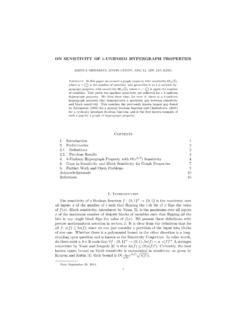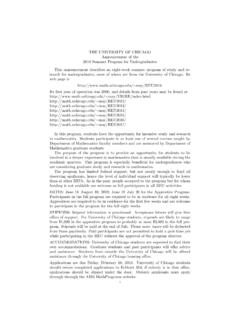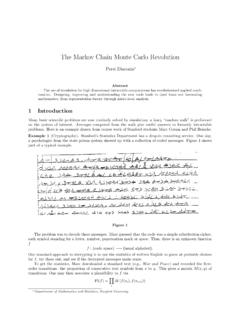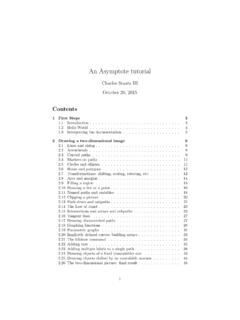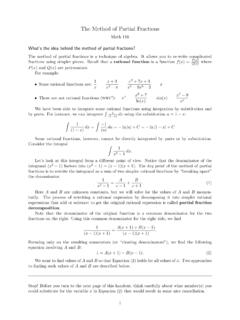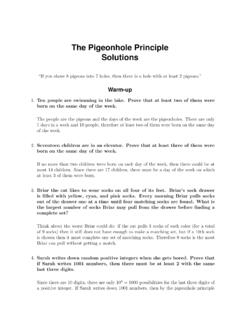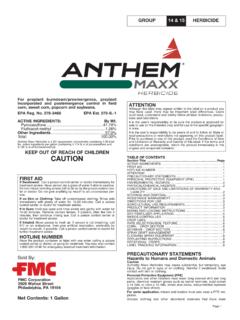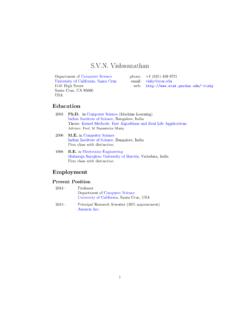Transcription of Contents Introduction to Sequences - University of Chicago
1 Introduction TO THE CONVERGENCE OF Sequences . BECKY LYTLE. Abstract. In this paper, we discuss the basic ideas involved in Sequences and convergence. We start by defining Sequences and follow by explaining convergence and divergence, bounded Sequences , continuity, and subsequences. Relevant theorems, such as the Bolzano-Weierstrass theorem, will be given and we will apply each concept to a variety of exercises. Contents 1. Introduction to Sequences 1. 2. Limit of a Sequence 2. 3. Divergence and Bounded Sequences 4. 4. Continuity 5. 5. Subsequences and the Bolzano-Weierstrass Theorem 5. References 7.
2 1. Introduction to Sequences Definition A sequence is a function whose domain is N and whose codomain is R. Given a function f : N R, f (n) is the nth term in the sequence. Example The first example of a sequence is xn = n1 . In this case, our function f is defined as f(n) = n1 . As a listed sequence of numbers, this would look like the following: . 1 1 1 1 1 1. ( ) 1, , , , , , .. 2 3 4 5 6 7. Another example of a sequence is xn = 5n , which would look like the following: ( ) (5, 25, 125, ). We know these are both valid examples of Sequences because they are infinite lists of real numbers and hence can be regarded as functions with domain N.
3 Example The following would not be an examples of Sequences : ( ) (1, 2, 3). ( ) (500, 200, 550, 10000). Date: July 12, 2015. 1. 2 BECKY LYTLE. We know that these are not examples of Sequences because they are finite lists of real numbers. 2. Limit of a Sequence A limit describes how a sequence xn behaves eventually as n gets very large, in a sense that we make explicit below. Definition A sequence of real numbers converges to a real number a if, for every positive number , there exists an N N such that for all n N, |an - a| <.. We call such an a the limit of the sequence and write limn an = a.
4 1. Proposition 1. The sequence n converges to zero. Proof. Let > 0. We choose N N such that N > 1 . Such a choice is always possible by the Archimedean property. To verify that this choice of N is appropri- ate, let n N satisfy n N . Then, n N implies n > 1 which is equal to n1 =. | n1 0 | < , proving that n1 converges to zero by the definition of convergence.. Proposition 2. An example of a sequence that does not converge is the following: ( ) (1, 1, 1, 1, ..). If a sequence does not converge, it is said to diverge, which we will explain later in the paper, along with the explanation of why the above sequence does not converge.
5 Proposition 3. If xn yn zn for all n N and limn xn =limn zn =l, then limn yn =l too. Proof. Let > 0. We want to show there exists an N such that for all n > N , | yn l |< . We know that xn l. Therefore, there exists an N1 such that for all n > N1 , | xn l |< . Also, we know that zn l. Therefore, there exists an N2. such that for all n > N2 , | zn l |< . Let N = max(N1 , N2 ) and n > N . Then, n > N1 so | xn l |< . Also, n > N2 so | zn l |< . We want to show that | yn l |< . This is equivalent to showing that both yn l < and l yn < . We know that yn zn , so yn l zn l < . Also, we know that yn xn , so l yn l xn <.
6 Theorem (Algebraic Limit Theorem). Let limn an = a and limn bn =. b. Then, (i) limn can = ca for all c R. (ii) limn (an + bn ) = a+b (iii) limn (an bn ) = ab (iv) limn (an /bn ) = a/b provided b 6= 0. Example If (xn ) 2, then ((2xn - 1)/3) 1. Proof. First, we will start with the information given in the example: xn 2. Next, we simply use the fact that ( 43 )( 32 ) = 2.. 4 3. ( ) xn . 3 2. Introduction TO THE CONVERGENCE OF Sequences 3. Now, let an = xn , and let a = ( 43 )( 32 ), and let c = ( 23 ). From the Algebraic Limit Theorem, we know that can ca. Then, ( 23 )(xn ) ( 23 )( 43 )( 32 ), which is equal to the following: 2xn 4.
7 ( ) . 3 3. The next step follows from the fact that 43 = 1 + 13 . 2xn 1. ( ) 1+. 3 3. Let 3 = an , let (1+ 3 ) = a, let bn = ( 3 , 3 , ..), and let b = 1. 2xn 1 1 1. 3 . Then, by the Algebraic Limit Theorem, we know that an + bn a + b. Therefore, we know that 2x3n + 1 1 1. 3 (1+ 3 ) + 3 , which is equal to the following: 2xn 1. ( ) 1. 3 3. This last step follows because 3 - 3 = 2xn3 1 . 2xn 1. 2xn 1. ( ) 1. 3. Therefore, using the Algebraic Limit Theorem, we have shown that if (xn ) 2, then ((2xn - 1)/3) 1.. Example The following sequence converges to the proposed limit . 2n + 1 2. ( ) lim =.
8 5n + 4 5. 2n 1 2n+1. Proof. Let 5n+4 be an , let 5n+4 be bn and let 5n+4 be cn , and cn = an + bn . By Theorem , we know that lim(cn ) = lim (an +bn ) = lim(an )+lim(bn ). We must therefore determine what lim(an ) and lim(bn ) are. 1. First, we will show that lim( 5n+4 ) = 0. Let > 0. By the Archimedean principle, 1. there exists an N N such that N > 1/ . Then, for n > N , 5n+4 < 5N1+4 < 1/N. 1. < . Therefore, the limit of 5n+4 is zero. Then, because lim(cn ) = lim(an +bn ), lim(cn ) = lim(an + 0) = lim(an ). We will 2n+1. therefore find the limit of an in order to prove lim( 5n+4 ) = 25.
9 2n 2. We now want to show that lim( 5n+4 ) = 5 . Let > 0. By the Archimedean Principle, there exists an N such that 1/ < N. Let n > N . We then want to show the following: 2n 2 ( ) . 5n + 4 5 < . Then, 2n 2 8 ( ) 5n + 4 5 = 5(5n + 4) 4 BECKY LYTLE. We have to check the following: 8. ( ) < . 5(5n + 4). 8. ( ) < . 5(5n + 4). 8. We know that the inequality 5(5n+4) < is true for every value of n because n 8. > N > 1/ and . Therefore we only need to show that the inequality 5(5n+4) < . is true. Using the fact that N > 1/ , we can say the following: 8 8 8 . ( ) < =. 5(5n + 4) 5(5(1/ ) + 4) 25 + 20.
10 8 8 8. Then, 25+20 < 25 < . Therefore, 5(5n+4) < .. Example Let xn 0. If (xn ) 0, then ( xn ) 0.. Proof. First, we have to prove that lim( xn ) exists. We know that xn is decreasing but is greater than or equal to 0 for all values of n. The square root of a positive . number is also positive. Therefore, xn 0. Also, note that if 0< a < b, then . 0< a< b. So if xn is decreasing, then so is xn . Therefore, lim( xn ) exists.. Next, we must prove that ( xn ) 0. Let lim(xn ) = lim(( xn )( xn )) = 0. By the Algebraic Limit Theorem, we know that if lim(an ) = a and lim(bn ) = b then . lim((an )(bn )) = ab.

